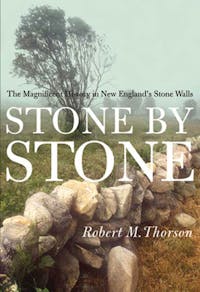Stone by Stone
The Magnificent History in New England's Stone Walls
 Download image
Download image
ISBN10: 0802776876
ISBN13: 9780802776877
Paperback
304 Pages
$20.00
There once may have been 250,000 miles of stone walls in America's Northeast, stretching farther than the distance to the moon. They took three billion man-hours to build. And even though most are crumbling today, they contain a magnificent scientific and cultural story about the geothermal forces that formed their stones, the tectonic movements that brought them to the surface, the glacial tide that broke them apart, the earth that held them for so long, and the humans who built them.
Stone walls tell nothing less than the story of how New England was formed, and in Robert Thorson's hands they live and breathe. "The stone wall is the key that links the natural history and human history of New England," Thorson writes. Millions of years ago, New England's stones belonged to ancient mountains thrust up by prehistoric collisions between continents. During the Ice Age, pieces were cleaved off by glaciers and deposited—often hundreds of miles away—when the glaciers melted. Buried again over centuries by forest and soil buildup, the stones gradually worked their way back to the surface, only to become impediments to the farmers cultivating the land in the eighteenth century, who piled them into "linear landfills," a place to hold the stones. Usually the biggest investment on a farm, often exceeding that of the land and buildings combined, stone walls became a defining element of the Northeast's landscape, and a symbol of the shift to an agricultural economy.
Stone walls layer time like Russian dolls, their smallest elements reflecting the longest spans, and Thorson urges us to study them, for each stone has its own story. Linking geological history to the early American experience, Stone by Stone presents a fascinating picture of the land the Pilgrims settled, allowing us to see and understand it with new eyes.
Reviews
Praise for Stone by Stone
"An open invitation to head into the country oneself and explore a stone wall."—The Boston Globe
"[A] fascinating study of New England's landmarks that are as much about art as geology."—The Dallas Morning News
"As Thorson writes in his introduction, 'Abandoned stone walls are the signatures of rural New England.' The only national fencing census, made in 1871, estimated that there were approximately 240,000 miles of these 'signatures.' In telling their story, Thorson (geology and geophysics, Univ. of Connecticut) weaves together cultural and environmental histories with geography and natural science . . . [He] describes how the size, shape, and color of stones indicate how and where they were formed. These stones, as a natural resource of New England, shaped the culture of the region, beginning with the soil movement that yielded the stones from the ground. The resulting walls created microclimates and supported plant life while delineating property boundaries of the small family farms. Thorson traces the growth and decline of the farms and discusses the technological changes that resulted in the transition from an agricultural to an industrial nation. The author knows his subject thoroughly and communicates his enthusiasm."—Denise Hamilton, Library Journal
"'To know New England well, one must know its stone walls,' writes the author of this authoritative paean to the structures he calls the 'signatures of rural New England.' There were once approximately 240,000 miles of stone walls in New England, and Thorson, a professor of geology and geophysics at the University of Connecticut, combines natural history and human history as he tells the story of the walls and how they were built. In his geo-archeological study, he begins by exploring how the stones, formed deep within the earth, were shaped and scattered by glaciation, buried under forest and soil buildup, brought to the surface after the New England pioneers cut down the trees and exposed the soil to frost heave, and tossed to the sides of their fields by early farmers clearing the land. He finds these tossed walls, which make up the majority of stone walls in New England, as aesthetically pleasing as the carefully constructed walls that came later. Every type of stone wall fascinates him. He extols their color, form and texture, the sounds they make, the shelter they provide for animals, their beauty as they disintegrate. As agriculture declined in the region, the walls were neglected, and today they are 'almost as sad as they are simple,' he says, for they are evidence of a lost Yankee culture. Now most of the walls have been abandoned, and their stones have become a cash crop to be sold and often carried far away from their original locations, which Thorson considers an 'environmental tragedy.' His book covers much technical material, but his enthusiasm for the subject brings it to life. Copious notes, extensive bibliography and an appendix with geologic time lines are included."—Publishers Weekly

